 Facebook, Inc. (NASDAQ:FB) of Menlo Park, CA, is best known for its hugely popular online social media website. Incredibly, the website recently welcomed one billion visitors to its digital platform on August 24th, meaning that nearly one out of every seven people living in the world logged onto Facebook that day. Facebook is the platform of choice for many social media participants and a recent study by food and drink market research firm Sopexa shows that 81 percent of online users posting food content, also known as “foodies,” use Facebook compared to the 18 percent who frequent Pinterest. As we discussed in our coverage of a recent report on e-businesses released by the American Consumer Satisfaction Index, Facebook had the greatest one-year gains of any e-business in terms of consumer satisfaction.
Facebook, Inc. (NASDAQ:FB) of Menlo Park, CA, is best known for its hugely popular online social media website. Incredibly, the website recently welcomed one billion visitors to its digital platform on August 24th, meaning that nearly one out of every seven people living in the world logged onto Facebook that day. Facebook is the platform of choice for many social media participants and a recent study by food and drink market research firm Sopexa shows that 81 percent of online users posting food content, also known as “foodies,” use Facebook compared to the 18 percent who frequent Pinterest. As we discussed in our coverage of a recent report on e-businesses released by the American Consumer Satisfaction Index, Facebook had the greatest one-year gains of any e-business in terms of consumer satisfaction.
Operations for Facebook continue to grow, even in rural areas, as is evidenced by the recent announcement of the opening of a third data center in Prineville, OR, to service users in rural Oregon. The social media giant is also developing a virtual assistant known as ‘M’ which hopes to compete with rival virtual assistants like Cortana from Google Inc. (NASDAQ:GOOG) or Siri from Apple Inc. (NASDAQ:AAPL). In the political realm, it may be interesting to note whether ties between Facebook and Washington, D.C., are affected at all by the White House’s recent hiring of a Facebook employee to serve as the federal government’s first Director of Product, overseeing digital properties such as WhiteHouse.gov and the We the People petition website.
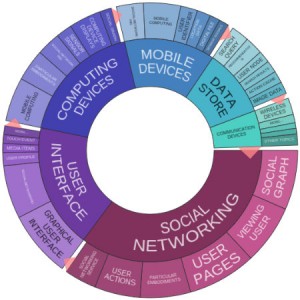 Facebook has been experiencing an uptick in terms of its intellectual property holdings in recent years. In 2014, the company was tied with Emerson Electric for 132nd overall with 279 patents issued that year by the U.S. Patent and Trademark Office, an increase of almost 120 percent over the company’s patenting pace the previous year. Facebook’s already earned 250 U.S. patents in 2015 according to Innography, making it very likely that the company will post higher patent totals this year. The text cluster provided here shows us that much of the company’s recent innovation focuses on social networking, although user interfaces and computing devices were also large areas of focus.
Facebook has been experiencing an uptick in terms of its intellectual property holdings in recent years. In 2014, the company was tied with Emerson Electric for 132nd overall with 279 patents issued that year by the U.S. Patent and Trademark Office, an increase of almost 120 percent over the company’s patenting pace the previous year. Facebook’s already earned 250 U.S. patents in 2015 according to Innography, making it very likely that the company will post higher patent totals this year. The text cluster provided here shows us that much of the company’s recent innovation focuses on social networking, although user interfaces and computing devices were also large areas of focus.
[Companies-1]
Facebook’s Issued Patents: From Streaming Social Media Content to Sports Activity Tracking
Social networking was at the center of a couple of patents that we noticed during our recent survey of Facebook’s issued patents, such as is the case with U.S. Patent No. 9110929, entitled Sharing Television and Video Programming Through Social Networking. This patent claims a method of determining a media devices of first and second users of a social networking system, accessing a social graph of the social networking system having a plurality of nodes associated with social networking system users and connected by edges, updating the social graph based on the devices of the first and second users to create a new concept node, determining an optimal media device of the second user based on the updated graph and streaming media from the first device to the optimal media device of the second user. This media streaming innovation enables social networking system users to view content simultaneously on multiple devices. Automated personal profile pages for social networking system users are
discussed within U.S. Patent No. 9092826, which is titled Profile Page with Biographical Summary for Social Networking System User. This patent discloses a method of 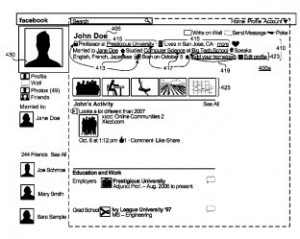 maintaining profile stores including biographical information items of multiple users of a social networking system, determining biographical information items from a first user which are temporarily relevant in response to a request from a second user, selecting multiple biographical information items as most relevant to the second user, concatenating the items into a short biography for displaying to a second user and generating a profile page of the first user for viewing by the second user including a first section corresponding to the short biography and a second section corresponding to the first user’s biographical information. This innovation intends to enable more effective social networking by providing users with the biographical information about other users which is most relevant to the user seeking out information.
maintaining profile stores including biographical information items of multiple users of a social networking system, determining biographical information items from a first user which are temporarily relevant in response to a request from a second user, selecting multiple biographical information items as most relevant to the second user, concatenating the items into a short biography for displaying to a second user and generating a profile page of the first user for viewing by the second user including a first section corresponding to the short biography and a second section corresponding to the first user’s biographical information. This innovation intends to enable more effective social networking by providing users with the biographical information about other users which is most relevant to the user seeking out information.
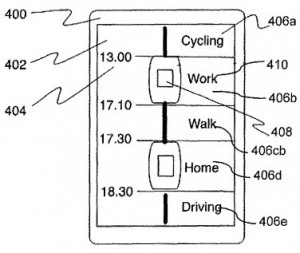 Anyone who already feels like social networks collect too much personal data may not be happy to find out about the invention protected by U.S. Patent No. 9118725, issued under the title User Activity Tracking System. The method claimed here involves receiving sensor signals from a client device which correspond to motions of the client device, determining an activity of the user by associating sensor signals with activity periods comprising a geographic location and selecting activity types corresponding to each activity period. This invention is designed to better determine the exact sports activity in which a user is engaged. Geographical location of social network users is at the center of U.S. Patent No. 9097531, titled Human-Like Global Positioning System (GPS) Directions. The method protected here involves receiving a request for a route to a first geolocation to a second geolocation, calculating the route between the two geolocations, identifying inferred paths that coincide with a portion of the route, replacing one or more route navigation instructions with abbreviated navigation instructions associated with the inferred paths and providing a set of navigation instructions including the abbreviated navigation instructions. This system is designed to track frequently traveled routes of a user and present them for inclusion when determining GPS directions to a destination.
Anyone who already feels like social networks collect too much personal data may not be happy to find out about the invention protected by U.S. Patent No. 9118725, issued under the title User Activity Tracking System. The method claimed here involves receiving sensor signals from a client device which correspond to motions of the client device, determining an activity of the user by associating sensor signals with activity periods comprising a geographic location and selecting activity types corresponding to each activity period. This invention is designed to better determine the exact sports activity in which a user is engaged. Geographical location of social network users is at the center of U.S. Patent No. 9097531, titled Human-Like Global Positioning System (GPS) Directions. The method protected here involves receiving a request for a route to a first geolocation to a second geolocation, calculating the route between the two geolocations, identifying inferred paths that coincide with a portion of the route, replacing one or more route navigation instructions with abbreviated navigation instructions associated with the inferred paths and providing a set of navigation instructions including the abbreviated navigation instructions. This system is designed to track frequently traveled routes of a user and present them for inclusion when determining GPS directions to a destination.
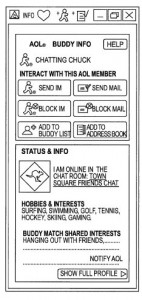 Personal assistant technologies related to the new Facebook M virtual assistant are detailed within U.S. Patent No. 9075867, entitled Intelligent Results Using an Assistant. The method claimed here involves receiving a character stream of non-completion characters input by a user, analyzing the character stream with an assistant, initiating a search related to analysis of the character stream and displaying search results prior to input of a completion character by a user. This system for providing results which predict user interests is designed to reduce the challenges in navigating large stores of information available online.
Personal assistant technologies related to the new Facebook M virtual assistant are detailed within U.S. Patent No. 9075867, entitled Intelligent Results Using an Assistant. The method claimed here involves receiving a character stream of non-completion characters input by a user, analyzing the character stream with an assistant, initiating a search related to analysis of the character stream and displaying search results prior to input of a completion character by a user. This system for providing results which predict user interests is designed to reduce the challenges in navigating large stores of information available online.
A greater flexibility for Facebook’s Messenger instant messaging service seems to be the focal point of U.S. Patent No. 9043419, titled Associating Online Identities Between Different Messaging Services. This patent protects a method of subscribing a user of a first communication service to a second communication service, requesting a first user identifier for the user, storing the first identifier, storing a second identifier after the user is subscribed to the second communication service, associating both identifiers with each other, receiving contact list information associated with a user’s first communication service, identifying user identities associated with the second communication service corresponding to identities in the first contact list and populating a second contact list with the identified user identities associated with the second service. This innovation is intended to improve the ease at which messaging service users can switch between those services.
[Companies-2]
Patent Applications of Note: From Social Network e-Commerce to Speech Recognition Vocabulary Learning
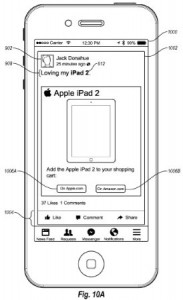 Various improvements to Facebook’s social networking service are again clearly on display in the company’s recent patent application filings, as can be seen within U.S. Patent Application No. 20150100458, titled Systems and Methods for Using a Social Networking System to Purchase Products. The method that would be protected here involves providing communication including information to purchase a product to a social networking system user, providing a selectable option to purchase the product from the social networking system and initiating a purchase of the product in response to a selection of the selectable option by a user. This invention seeks to facilitate e-commerce directly through Facebook’s social networking platform. Automated techniques for organizing media content uploaded to a social network by a user are described within U.S. Patent Application No. 20150104059, entitled Automatic Photo Album Creation Based on Social Information. This would protect a method of storing profiles for a plurality of social networking system users, storing information for a plurality of social networking system objects, storing a plurality of connections between the users and the objects, accessing a plurality of images posted by a user, receiving a request to access an album comprising a set of images selected from the plurality of images, identifying tagged objects in the images of the album, computing a score for each of the images based in part on an association between user profile information and tagged objects, selecting a subset of the plurality of images based on the computed scores and sending an album comprising the selected subset of images for display to a viewing user. This technology is intended to automate the process of curating photos uploaded to a social network, which can be time consuming. Online message boards made available by social networking systems will receive improved controls thanks to the invention outlined within U.S. Patent Application No. 20150163184, which is titled Moderating Content in an Online Forum. This patent application discloses a method of receiving a comment from a posting user that is posted on a page within a social networking system, determining that the comment contains proscribed content and displaying the page including the comment to the posting user while displaying a page not including the comment to social networking system users not connected to the posting user. This technology is intended to help online forum moderators strike a better balance between encouraging open discussion and weeding out inappropriate comments from users.
Various improvements to Facebook’s social networking service are again clearly on display in the company’s recent patent application filings, as can be seen within U.S. Patent Application No. 20150100458, titled Systems and Methods for Using a Social Networking System to Purchase Products. The method that would be protected here involves providing communication including information to purchase a product to a social networking system user, providing a selectable option to purchase the product from the social networking system and initiating a purchase of the product in response to a selection of the selectable option by a user. This invention seeks to facilitate e-commerce directly through Facebook’s social networking platform. Automated techniques for organizing media content uploaded to a social network by a user are described within U.S. Patent Application No. 20150104059, entitled Automatic Photo Album Creation Based on Social Information. This would protect a method of storing profiles for a plurality of social networking system users, storing information for a plurality of social networking system objects, storing a plurality of connections between the users and the objects, accessing a plurality of images posted by a user, receiving a request to access an album comprising a set of images selected from the plurality of images, identifying tagged objects in the images of the album, computing a score for each of the images based in part on an association between user profile information and tagged objects, selecting a subset of the plurality of images based on the computed scores and sending an album comprising the selected subset of images for display to a viewing user. This technology is intended to automate the process of curating photos uploaded to a social network, which can be time consuming. Online message boards made available by social networking systems will receive improved controls thanks to the invention outlined within U.S. Patent Application No. 20150163184, which is titled Moderating Content in an Online Forum. This patent application discloses a method of receiving a comment from a posting user that is posted on a page within a social networking system, determining that the comment contains proscribed content and displaying the page including the comment to the posting user while displaying a page not including the comment to social networking system users not connected to the posting user. This technology is intended to help online forum moderators strike a better balance between encouraging open discussion and weeding out inappropriate comments from users.
 Parents who want to clean up the newsfeed being presented to a child that may be using a social network should get a helping hand from the technology detailed within U.S. Patent Application No. 20150234916, issued under the title Community-Based Parental Controls. The method claimed here involves maintaining rating groups that provide ratings relating to a piece of content and containing multiple users who evaluate multiple pieces of content, receiving a selection of a first rating group from a first user to be applied to a set of users associated with the first user, determining that a user sending the request belongs to the set of users associated with the first user, accessing information associated with the first rating group, determining that the first rating group includes a rating for the requested content and determining whether or not to provide information to the requesting user based on the indication or absence of a rating for the requested piece of content within the first rating group. This technique of using content rating groups is intended to improve the ability of rating online content as appropriate for viewing by others.
Parents who want to clean up the newsfeed being presented to a child that may be using a social network should get a helping hand from the technology detailed within U.S. Patent Application No. 20150234916, issued under the title Community-Based Parental Controls. The method claimed here involves maintaining rating groups that provide ratings relating to a piece of content and containing multiple users who evaluate multiple pieces of content, receiving a selection of a first rating group from a first user to be applied to a set of users associated with the first user, determining that a user sending the request belongs to the set of users associated with the first user, accessing information associated with the first rating group, determining that the first rating group includes a rating for the requested content and determining whether or not to provide information to the requesting user based on the indication or absence of a rating for the requested piece of content within the first rating group. This technique of using content rating groups is intended to improve the ability of rating online content as appropriate for viewing by others.
More messaging service innovation can be seen on display within U.S. Patent Application No. 20150215787, which is titled Phone Number Verification Method and System. The method claimed here involves obtaining an unconfirmed phone number for a phone device, transmitting a verification message from the phone device over a data channel of a voice network to the unconfirmed phone number, receiving the verification message at the phone device and indicating that the phone device is verified as being associated with the unconfirmed phone number responsive to the verification message. This system allows phone device users to communicate via text message without incurring SMS text messaging rates charged by some network providers.
Methods for determining how engaging pieces of online social content are to a social network user are featured within U.S. Patent Application No. 20150142954, titled Systems and Methods for Estimating User Attention. The computer-implemented method disclosed here involves identifying first activity data indicating activities of a first user on a website or application, detecting a first predetermined period of inactivity in the first activity data, initiating a response triggering event after the predetermined period of inactivity, monitoring for an indication of a user response and determining whether the user is passively present on the website or application based on the monitoring. This social networking optimization technology is designed to determine pages and content which garner little attention in order to better provision popular social content.
![]() Finally, we were intrigued to get a look at an invention in the field of spoken word language translation, found within U.S. Patent Application No. 20150127321, entitled Lexicon Development via Shared Translation Database. The method that would be protected here involves receiving an utterance in a first language from a user which includes a first term associated with the field term, translating the utterance from the first language into a second language, receiving an indication to add the first field-associated term to a recognition lexicon of a first automatic speech recognition module of the speech translation system, adding the first term and at least a portion of the utterance translation to a machine translation module associated with the first language of the speech recognition system and adding the first term and the portion of the utterance in a second language to a shared community database. This system for updating the vocabulary of a speech recognition system for the correction of recognition errors over time.
Finally, we were intrigued to get a look at an invention in the field of spoken word language translation, found within U.S. Patent Application No. 20150127321, entitled Lexicon Development via Shared Translation Database. The method that would be protected here involves receiving an utterance in a first language from a user which includes a first term associated with the field term, translating the utterance from the first language into a second language, receiving an indication to add the first field-associated term to a recognition lexicon of a first automatic speech recognition module of the speech translation system, adding the first term and at least a portion of the utterance translation to a machine translation module associated with the first language of the speech recognition system and adding the first term and the portion of the utterance in a second language to a shared community database. This system for updating the vocabulary of a speech recognition system for the correction of recognition errors over time.

![[IPWatchdog Logo]](https://ipwatchdog.com/wp-content/themes/IPWatchdog%20-%202023/assets/images/temp/logo-small@2x.png)


![[Advertisement]](https://ipwatchdog.com/wp-content/uploads/2024/04/Artificial-Intelligence-2024-REPLAY-sidebar-700x500-corrected.jpg)
![[Advertisement]](https://ipwatchdog.com/wp-content/uploads/2024/04/UnitedLex-May-2-2024-sidebar-700x500-1.jpg)
![[Advertisement]](https://ipwatchdog.com/wp-content/uploads/2024/04/Patent-Litigation-Masters-2024-sidebar-700x500-1.jpg)

![[Advertisement]](https://ipwatchdog.com/wp-content/uploads/2021/12/WEBINAR-336-x-280-px.png)
![[Advertisement]](https://ipwatchdog.com/wp-content/uploads/2021/12/2021-Patent-Practice-on-Demand-recorded-Feb-2021-336-x-280.jpg)
![[Advertisement]](https://ipwatchdog.com/wp-content/uploads/2021/12/Ad-4-The-Invent-Patent-System™.png)






Join the Discussion
No comments yet.